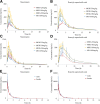Pharmacokinetics and tissue distribution of monotropein and deacetyl asperulosidic acid after oral administration of extracts from Morinda officinalis root in rats
- PMID: 30355303
- PMCID: PMC6201592
- DOI: 10.1186/s12906-018-2351-1
Pharmacokinetics and tissue distribution of monotropein and deacetyl asperulosidic acid after oral administration of extracts from Morinda officinalis root in rats
Abstract
Background: Iridoid glycosides (IGs), including monotropein (MON) and deacetyl asperulosidic acid (DA) as the main ingredients, are the major chemical components in Morinda officinalis How. (MO) root, possessing various pharmacological properties including anti-osteoporosis, anti-inflammation and anti-rheumatism activities.The aim of the present study was to further elucidate the pharmacological actions of MO by investigating the pharmacokinetics and tissue distribution of IGs in MO.
Methods: An ultra high performance liquid chromatography-tandem mass spectrometry (UHPLC-MS) method was developed and validated for simultaneous determination of MON and DA levels in plasma and various tissues of Wistar rats. MON, DA and acetaminophen (ACE) as the internal standard (IS) were extracted from rat plasma and tissue samples by direct deproteinization with methanol. The rats were administered orally at 1650 mg/kg MO and 25, 50 and 100 mg/kg MO iridoid glycosides (MOIGs) or intravenously at MOIG 25 mg/kg for pharmacokinetic study of MON and DA. In addition, 100 mg/kg MOIG was administered orally for tissue distribution study of MON and DA. Non-compartmental pharmacokinetic profiles were constructed. Tissue distributions were calculated according to the validated methods.
Results: Significant differences in the pharmacokinetic parameters were observed in male and female rats. The AUC0-t, Cmax and bioavailability of MON and DA in female rats were higher than those in male rats. MON and DA mainly distributed in the intestine and stomach after oral administration, and noteworthily high concentrations of MON and DA were detected in the rat hypothalamus.
Conclusion: The results of the present study may shed new lights on the biological behavior of MOIGs in vivo, help explain their pharmacological actions, and provide experimental clues for rational clinical use of these IGs extracted from the MO root.
Keywords: Iridoid glycosides; Morinda officinalis; Pharmacokinetics; Tissue distribution; UPLC-MS/MS.
Conflict of interest statement
Competing interest
The authors declare that they have no competing interests.
Ethics approval and consent to participate
All animal protocols were approved by the Experimental Animal Ethic Committee of the Second Military Medical University (No. SMMU-Pharm-0004).
Consent for publication
No applicable.
Publisher’s Note
Springer Nature remains neutral with regard to jurisdictional claims in published maps and institutional affiliations.
Figures




Similar articles
-
LC/MS/MS determination and pharmacokinetic study of iridoid glycosides monotropein and deacetylasperulosidic acid isomers in rat plasma after oral administration of Morinda officinalis extract.Biomed Chromatogr. 2016 Feb;30(2):163-8. doi: 10.1002/bmc.3532. Epub 2015 Jul 2. Biomed Chromatogr. 2016. PMID: 26053360
-
Morinda officinalis How. - A comprehensive review of traditional uses, phytochemistry and pharmacology.J Ethnopharmacol. 2018 Mar 1;213:230-255. doi: 10.1016/j.jep.2017.10.028. Epub 2017 Nov 7. J Ethnopharmacol. 2018. PMID: 29126988 Review.
-
Simultaneous Analysis of Iridoid Glycosides and Anthraquinones in Morinda officinalis Using UPLC-QqQ-MS/MS and UPLC-Q/TOF-MSE.Molecules. 2018 May 3;23(5):1070. doi: 10.3390/molecules23051070. Molecules. 2018. PMID: 29751518 Free PMC article.
-
Comparison of Anthraquinones, Iridoid Glycosides and Triterpenoids in Morinda officinalis and Morinda citrifolia Using UPLC/Q-TOF-MS and Multivariate Statistical Analysis.Molecules. 2019 Dec 31;25(1):160. doi: 10.3390/molecules25010160. Molecules. 2019. PMID: 31906109 Free PMC article.
-
Isolation, phytochemistry, characterization, biological activity, and application of Morinda officinalis How oligosaccharide: a review.J Pharm Pharmacol. 2024 May 3;76(5):437-461. doi: 10.1093/jpp/rgad096. J Pharm Pharmacol. 2024. PMID: 37991722 Review.
Cited by
-
Monotropein Protects against Inflammatory Bone Loss and Suppresses Osteoclast Formation and Bone Resorption by Inhibiting NFATc1 via NF-κB and Akt/GSK-3β Pathway.Nutrients. 2022 Sep 24;14(19):3978. doi: 10.3390/nu14193978. Nutrients. 2022. PMID: 36235631 Free PMC article.
-
Transcriptome-based identification and functional characterization of iridoid synthase involved in monotropein biosynthesis in blueberry.Plant Direct. 2023 Jul 11;7(7):e512. doi: 10.1002/pld3.512. eCollection 2023 Jul. Plant Direct. 2023. PMID: 37440931 Free PMC article.
-
Morinda officinalis oligosaccharides mitigate depression-like behaviors in hypertension rats by regulating Mfn2-mediated mitophagy.J Neuroinflammation. 2023 Feb 10;20(1):31. doi: 10.1186/s12974-023-02715-y. J Neuroinflammation. 2023. PMID: 36765376 Free PMC article.
-
Monotropein resists atherosclerosis by reducing inflammation, oxidative stress, and abnormal proliferation and migration of vascular smooth muscle cells.Korean J Physiol Pharmacol. 2025 Mar 1;29(2):245-255. doi: 10.4196/kjpp.24.352. Korean J Physiol Pharmacol. 2025. PMID: 39972674 Free PMC article.
-
Morinda officinalis iridoid glycosides, as an inhibitor of GSK-3β, alleviates rheumatoid arthritis through inhibition of NF-κB and JAK2/STAT3 pathway.Front Pharmacol. 2024 Oct 9;15:1435274. doi: 10.3389/fphar.2024.1435274. eCollection 2024. Front Pharmacol. 2024. PMID: 39444614 Free PMC article.
References
-
- Wang YF, Li YH, Xing SQ, Li Y, Yi LZT, Shang XD, Zhao DF, Bai LQ. Review of experiment research progress in treating deficiency of kidney-yang syndrome by Morinda officinalis how. And its effective components. China J Tradit Chin Med Pharm. 2016;31:5165–5167.
-
- Ye WH, Gong MJ, Zou ZJ. Metabonomic study of anti-inflammatory effect of Morinda officinalis How on acute inflammation induced by carrageenan. Pharm Clin Chin Mater Med. 2013;3:22–25.
-
- Chen DL, Yang X, Yang J, Lai GX, Yong TQ, Tang XC, Shuai O, Zhou GL, Xie YZ, Wu QP. Prebiotic effect of fructooligosaccharides from Morinda officinalis on Alzheimer’s disease in rodent models by targeting the microbiota-gut-brain axis. Front Aging Neurosci. 2017;9:403–430. doi: 10.3389/fnagi.2017.00403. - DOI - PMC - PubMed
MeSH terms
Substances
Grants and funding
LinkOut - more resources
Full Text Sources
Miscellaneous

